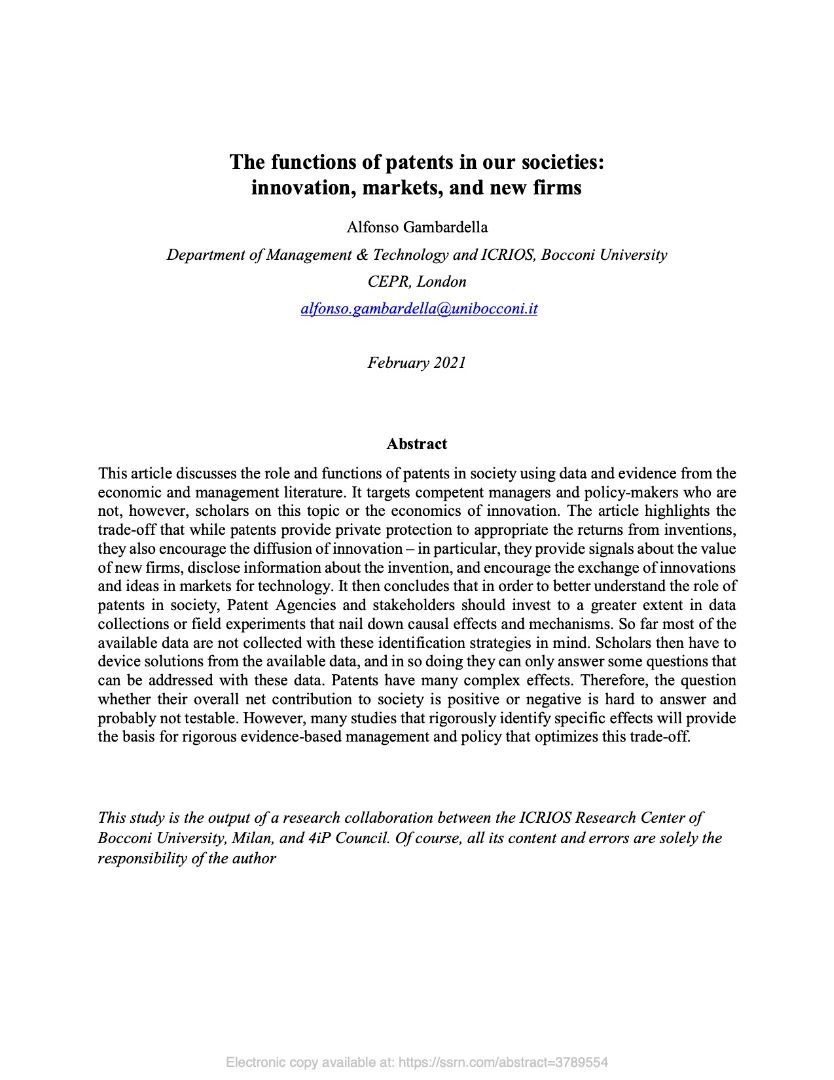Executive Summary
This article discusses the role and functions of patents in society. Its target audience is managers and policy-makers who are competent about the subject but are not professional scholars on this topic or the economics of innovation. In this respect, the goal of the article is to discuss patents and their impacts in our societies using data and evidence from the economic literature. The article does not intend to be exhaustive about all relevant issue and problems about patents. It has selected some issues and problems that the author believes are worth considering, but that do not exhaust all relevant questions on this topic.
The theme of this article is that while the most diffused view about patents is that they provide private protection to appropriate the returns of investments that generate innovations, they also have social functions that encourage the diffusion of innovation. The first social function is that the inventions that patents encourage, and that would not be produced otherwise, contribute to produce future innovations. In addition, patents have direct social functions. This article highlights that they provide signals about the value of new firms, disclose information about the invention, and encourage the exchange of innovations and ideas in markets for technology. Using existing literature and data, the article documents that these other functions are important. Moreover, they are especially important for smaller firms that today are a major vehicle for innovation and growth.
As far as the private value of patents is concerned, the article distinguishes between the value of patent rights and the value of invention. Since patents are assets, the value of patent rights is the discounted sum of the future returns from the economic exploitation of the invention when the owners can exclude others from using the patent. The value of invention is instead the overall value of the invention for society. The article’s primary estimates of the value of patent rights come from the InnoS&T survey. This survey asked a large sample of inventors to report the minimum price at which the owner of the patent would sell to a close competitor, on the day of grant, the set of patents technically connected to the focal patent. Note that this is not the “family” of patents, which is the set of patents that cover the same invention in different jurisdictions, but the “true” portfolio of different inventions that the inventors perceive as being technically connected.
Using the InnoS&T data, the estimated average value of patent portfolios is about 10 million euros. However, the median is about 0.5 million euros and the mode is 1.9 thousand euros. This suggests a very skewed distribution, with few patents worth hundreds million euros and most patents worth much less. Moreover, this distribution is not different across industries. Only the pharmaceutical industry shows a fatter right tail, with a higher share of patents worth hundreds million euros. This article also shows that these values are consistent with other studies in the literature. Recent studies in the literature show another interesting result: talented inventors capture a growing share of the value of patent rights in the form of higher wages.
The article documents several social functions of patents. First, using the InnoS&T data, it shows that smaller firms have a stronger propensity to use and license patents, and to use patents to create start-ups. Second, it documents, from existing literature, that patents provide signals of the value of new companies, generate new innovations because of the disclosure of information about extant inventions, and they encourage markets for technology. Studies that show the signaling value of patents and the effect of disclosure adopt rigorous identification strategy that makes us comfortable in concluding that they nail down the causal relation between the effect (signaling value or disclosure) and its consequence (better evaluations or innovations stemming from disclosure.)
Similarly, studies that show the importance of patents in markets for technology first argue that protection encourage firms to license their technologies – particularly small firms that cannot protect innovations using complementary assets. Second, they show the extent to which we can attribute this effect to the protection provided by patents. Finally, the article shows that patents encourage firms to license their general-purpose technologies to users in different application markets. This is an important social function of patents in that many firms could otherwise either integrate in these application markets or leave the technology unexploited in the markets in which they do not enter.
The article concludes by providing suggestions for deepening policy implications. It first remarks that society needs to monitor that patents continue to provide a virtuous function by preventing excessive monopolization of knowledge. The article then points out that we have the opportunity to address many questions about patents thanks to the considerable amount of data and information. However, so far, we have mainly taken an approach that starts from the available data on patents and address the questions we can address using these data. The downside is that we do not answer many important questions because we do not have the right data to deal with them.
We should turn to an approach that starts with the questions, and collects data that enable analysts and policy-makers to address these questions. In this respect, the article emphasizes that it is important to provide data or collect experiments that enable causal identifications of mechanisms. Understanding the mechanisms that determine specific effects of patents is crucial to design managerial and policy actions because the effects of these actions depend on the deployment of these mechanisms. Overall, this can help to make sizable steps that build on the extensive community of scholars that study patents, and generates systematic studies that are driven by important questions, use data that can nail down credible answers to these questions, and provide the basis for rigorous evidence-based management and policy about patents.
Key messages
- The classical function of patents is to provide rights to exclude others from using the inventions
- However, patents perform other functions that enhance the diffusion of innovations
- Thus, patents achieve both private and social goals
- They provide at least three important social functions, as discussed by the recent literature
- They provide signals that facilitate the evaluation of technology and the potential of new innovation-based firms
- They disclose information about innovations that encourages the production of new innovations
- They encourage firms to sell their technologies in markets for technology rather than integrating them into the production of final goods
- All three functions enhance the diffusion of innovations and makes the production and diffusion of innovations more efficient
- Moreover, they encourage the rise and development of innovative small firms which today are one of the most important vehicles of innovation and economic growth
- While this article reports results from the literature that document these points in a systematic way, there are still many open questions about the effects of patents
- We then need to encourage more studies that uncover these effects and provide new rigorous and systematic evidence, particularly on key questions that have not yet been answered or that need more thorough answers
- These studies call for new data that, in particular, nail down the causal effects of patents and the mechanisms that give rise to these effects
- The ability to collect and identify these data will rest on the collaboration of Patent Agencies, stakeholders and other institutions to design data collection processes and experiments that provide these causal identifications
- This will be an important step to move to solid evidence-based management and policies of patents
- It will also move the discussion from the generic question whether the net effect of patents in our societies is positive or negative, which can hardly be answered, to more relevant questions about what society can do to make patents both privately and socially more valuable






